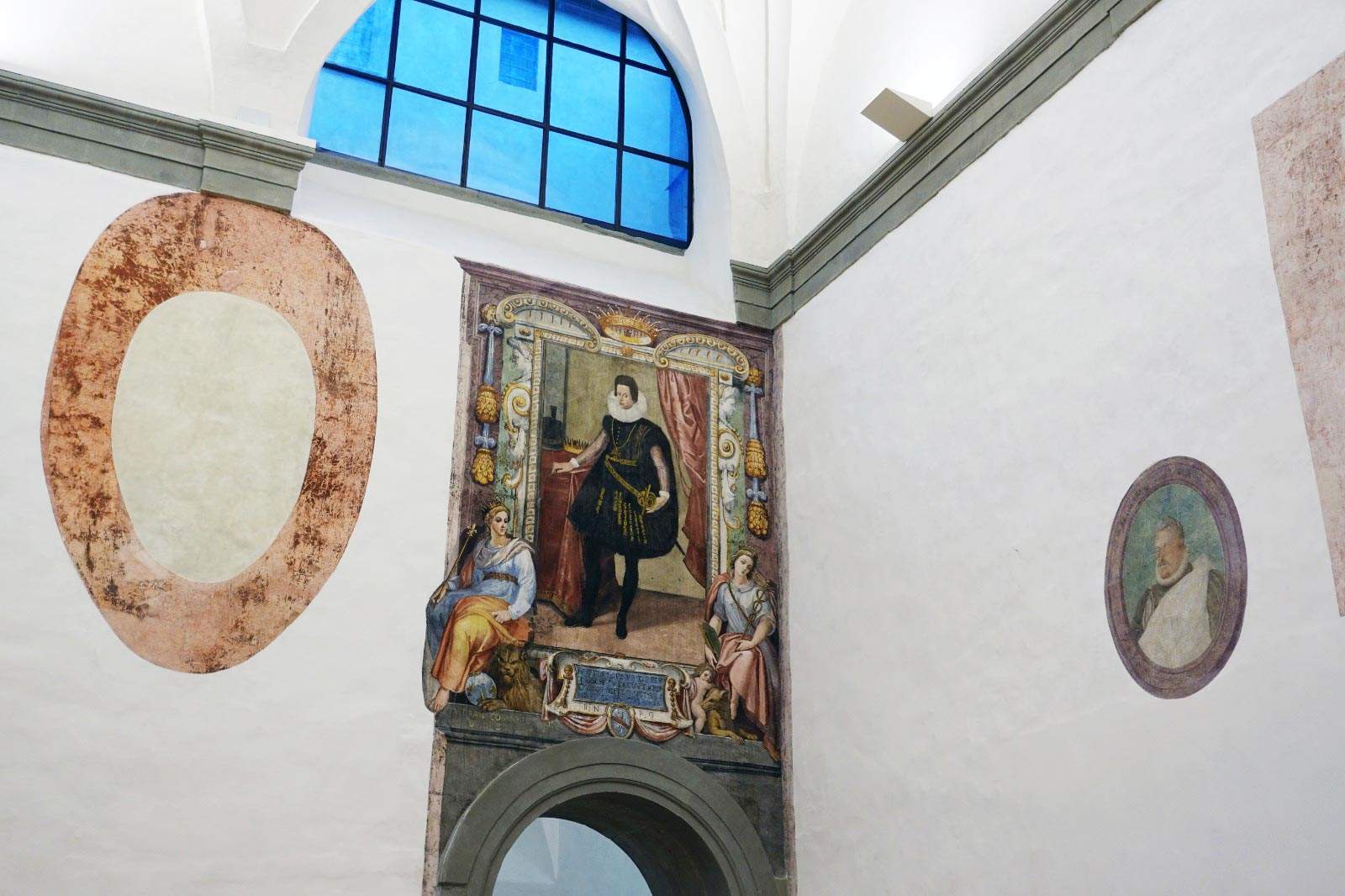New spaces at the Uffizi Galleries in Florence, with new discoveries as well: during recovery and restoration work on some rooms in the gallery’swest wing (the one closest to the Ponte Vecchio), two important 17th-century frescoes and other 18th-century paintings have resurfaced. They are two portraits of the grand dukes of Tuscany: the first fresco is a clypeus in which Grand Duke Ferdinand I is portrayed, while the second, the largest and most intact, is a full-length, life-size portrait of the young Cosimo II de’ Medici, with allegories of Florence and Siena, to be attributed to the ambit of the painter Bernardino Poccetti (Florence, 1548 - 1612). The superimposed fresco has resurfaced under the plaster of one room.
In the room next to the one where the frescoes of the two Medici were found, on the other hand, all the decorations executed in the 18th century, probably during the reign of Peter Leopold of Lorraine, have been unearthed. These are plant motifs that adorn the walls and the ceiling, in the center of which a panoply with lictor fasces is frescoed. These spaces, which are located on the first floor of the Gallery, will be part of the entrance to the museum and will be visible to the public.
In all, nearly 2,000 square meters, hitherto inaccessible, have been restored: a total of eight rooms in the west wing (409 square meters) and 14 rooms on the ground floor of the east wing (699 square meters) as well as 21 others (684 square meters) in the basement, as part of the work on the Nuovi Uffizi conducted by the Superintendency together with the Galleries, by architect Chiara Laura Tettamanti (director of works) and architect Francesco Fortino (single project manager). The new spaces available also entail a reorganization of the access modes to the Vasarian complex. As of the reopening, in fact, people will enter from the part closest to the Arno: tickets will be dispensed in the rooms of the Ponente wing, where a new checkroom for groups will also rise; the entrance to the museum will be opposite, on the ground floor of the Levante wing (here there will be the various reception points and a second checkroom). In the basement of the Levante wing, where the technical rooms and changing rooms for the Gallery’s staff have been located, the former Medici stables have also been restored. Having ticketed, visitors will exit to enter the museum from the opposite side of the forecourt, on the first floor of the Levante wing, with metal detector control of visitors and reception services such as distribution of audio guides and additional checkrooms. At the same time, restoration work will begin on the rooms that have housed the ticket offices and bookshop until now, and in about a year’s time they will be used to house classical statuary. In the meantime, visitors will reach the monumental staircase via a temporary route designed to allow the work to take place. At this provisional stage, visitors with mobility disabilities will be allowed to enter the Ponente wing, next to the Vasari auditorium: from here via elevators they will reach the second floor. A spacious new bookshop has been set up in the Knights’ Hall, replacing the former chaotic set of sales stalls and merchandise. The museum exit is still located in Piazza Del Grano.
“Over the past five years,” says Uffizi Director Eike D. Schmidt, “tremendous progress has been made in the rehabilitation of the spaces, progress that now allows more rational and safe access to the museum, and more efficiently organized reception points. Soon, when the ground-floor rooms of the Levante wing are rearranged, the visit to the Uffizi will be able to have a glorious introduction: the ground-floor rooms will in fact display classical statuary, with works from the deposits and others recently acquired.”
“Another step in the journey of the New Uffizi works, which today sees the handover to the Galleries of the rooms intended for visitor reception in addition to technical and service rooms,” says Andrea Pessina, Soprintendente Archeologia Belle Arti e Paesaggio for the Metropolitan City of Florence and the provinces of Pistoia and Prato. “This represents the fruit of the institutional collaboration of the highest quality and professionalism pursued in recent years by the Soprintendenza and the Uffizi Galleries with the contribution, also, of scholars and specialists from different disciplines. The construction site was, moreover, an opportunity for in-depth archaeological research in this area. The stratigraphic investigations that preceded the consolidation and restoration work, according to a schedule agreed upon by archaeologists and architects from the Superintendency and the Galleries, made it possible to initiate a historical-topographical study of this portion of Florence with reference to the very rich deposits of ceramics, glass, metals, animal bones recovered, as well as numerous burials, the remains of the foundations of numerous buildingsequipped with cellars where goods and foodstuffs were stored, with staircases, wells and disposals, now visible in the basements, restored, used from the Medici era as stables for the animals supplied to each Magistracy. The construction site of the New Uffizi, after the necessary reorganization imposed by the health emergency, is proceeding toward the final phase of the project.”
In the photo: the fresco with the young Cosimo II
 |
| Uffizi, 17th-century frescoes re-emerge from work that will revolutionize the entrance |
Warning: the translation into English of the original Italian article was created using automatic tools. We undertake to review all articles, but we do not guarantee the total absence of inaccuracies in the translation due to the program. You can find the original by clicking on the ITA button. If you find any mistake,please contact us.